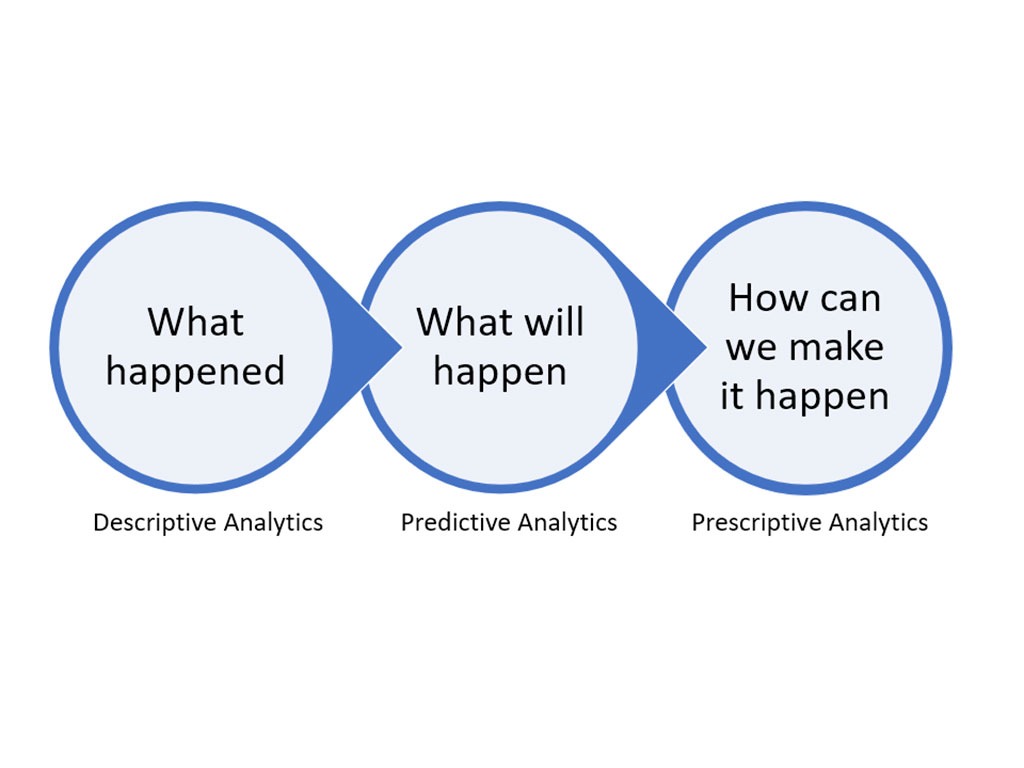What is Prescriptive Analytics and How Can it Help You?
Prescriptive analytics is a term coined by IBM and is usually called the final frontier of an analytics strategy.
In marketing, making data-driven decisions is key for business success, and with the use of computational sciences & mathematics, prescriptive analytics helps you take advantage of descriptive and predictive analytics.It is the third step (below) that goes beyond predictions and suggests the actions and implications of your marketing decisions. Prescriptive analytics not only anticipates what will happen and when it will happen but also answers the “why will it happen?” question, which is often posed by marketers.

What is Descriptive and Predictive Analytics?
Before we get into predictive analytics, let’s take a step back and consider what descriptive and predictive analytics are. Descriptive analytics is a field of statistics, usually the first step of analysis, which looks at historical data to yield information for further analysis. With the use of data mining techniques, you can understand reasons for success and failures in descriptive analytics. Predictive analytics is the step where historical data is combined with algorithms to predict results.
Research shows that marketers who use predictive analytics are 2.9 times more likely to experience an above-average revenue growth rate than the industry standards. Predictive analytics has helped tackle business problems and proved itself incredibly useful in calculating value-based KPI’s like customer lifetime value and customer profitability. Given the success businesses have seen using predictive analytics, why aren’t marketers using prescriptive analytics?
After all, it’s all about priorities. Organizations and marketing departments always have a lot going on, and prescriptive analytics usually gets lost down the track because of other marketing priorities. Martech has evolved so much that we need to prioritize what best suits customers and business needs. Being able to say which campaign will yield the best results and generate more revenue or which image should be used to get better results may sound too good to be true, but it’s possible with data science and prescriptive analytics.
Another problem is mindset. Most marketers don’t necessarily think like data scientists, since it’s about testing and experimenting. Therefore, it’s important to have a data science mindset and the capability that can help align data-driven decision making with your organizational goals.
The Bigger Picture
Prescriptive analytics helps marketers optimize their campaigns in real time. It allows marketers to make strategic decisions that yield better outcomes. Since there is real-time data available, specialists can make faster optimization decisions and understand what will work better for your brand, your audience, and your campaign goals.
Once the foundation for descriptive analytics, reporting, and business intelligence (BI) is set up, it’s ideal to move to predictive and prescriptive analytics.
Prescriptive analytics helps you find the best business decision. For example, if your goal is to drive sales or lead generation or optimize logistics & product deliveries, prescriptive analytics help you do that!
Scientific Disciplines that Comprise Prescriptive Analytics
- Machine learning
- Natural language processing
- Computer vision
- Image & Signal processing
- Applied statistical and mathematical analysis
- Operations research
Each discipline stands on its own and has a different purpose, but when combined together to give an output (business decision) prescriptive analytics comes to life. This is how it answers how we can make something happen.
Use Cases of Prescriptive Analytics
It starts with changing those predictions to decisions. While prescriptive analytics can continually take in new data to re-predict and re-prescribe, it automatically improves prediction accuracy and prescribes better decision options, and ingests hybrid data – a combination of structured (numbers, categories) and unstructured data (videos, images, sounds, texts), as well as business rules to predict what lies ahead and to prescribe how to take advantage of this predicted future without compromising other priorities.
Today, it is widely used in sales and marketing to make data-driven decisions and increase ROI and customer engagement. In logistics, UPS applied it to save $50M annually from a reduction of one mile driven per driver per day. They predicted routes and grouped delivery at a particular locality for better efficiency and also mapped it with when the customer wanted the delivery of their products. This ultimately helps them deliver better customer satisfaction too. This is a classic example of using analytics and predictions for solving complex problems and helping with difficult business decision making.
How could or how does the use of prescriptive analytics help your business? Let us know in the comments!
